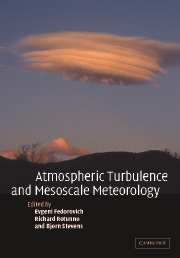Book contents
- Frontmatter
- Contents
- Preface
- Douglas K. Lilly: a biography
- Part I Atmospheric turbulence
- 1 Changing the face of small-scale meteorology
- 2 Phenomenological hunts in two-dimensional and stably stratified turbulence
- 3 Energy dissipation in large-eddy simulation: dependence on flow structure and effects of eigenvector alignments
- 4 Dreams of a stratocumulus sleeper
- 5 Large-eddy simulations of cloud-topped mixed layers
- Part II Mesoscale meteorology
- Appendix A Douglas K. Lilly: positions, awards, and students
- Appendix B List of publications by Douglas K. Lilly
- Index
- Plate section
5 - Large-eddy simulations of cloud-topped mixed layers
Published online by Cambridge University Press: 04 August 2010
- Frontmatter
- Contents
- Preface
- Douglas K. Lilly: a biography
- Part I Atmospheric turbulence
- 1 Changing the face of small-scale meteorology
- 2 Phenomenological hunts in two-dimensional and stably stratified turbulence
- 3 Energy dissipation in large-eddy simulation: dependence on flow structure and effects of eigenvector alignments
- 4 Dreams of a stratocumulus sleeper
- 5 Large-eddy simulations of cloud-topped mixed layers
- Part II Mesoscale meteorology
- Appendix A Douglas K. Lilly: positions, awards, and students
- Appendix B List of publications by Douglas K. Lilly
- Index
- Plate section
Summary
Introduction
With the advent of computers, scientists in the 1950s and 1960s began to explore the possibility of using numerical simulation to generate virtual laboratories for exploring specific geophysical processes in a controlled manner. Doug Lilly helped pioneer this emerging science of numerical simulation. As pointed out by Wyngaard (Chapter 1), Lilly presented a “bold, three-phase plan of attack” in which well-behaved numerical models would be developed; their fidelity would be benchmarked against known solutions; and as confidence builds they would be used to explore conditions not adequately reproducible by experiment. In the subsequent decades this strategy has become a staple of theoretical studies of turbulence. In particular, a class of numerical simulations Doug helped develop in the early 1960s has come to be known as large-eddy simulation (LES) and is now widely used in the field of planetary boundary layer (PBL) turbulence and clouds.
We begin in Section 5.2 by giving an example of the second element of Doug's plan of attack, and what we call “benchmarking.” This is by no means trivial, because for turbulent flows there are no known solutions. To better appreciate this point we consider LES of the cloud-topped boundary layer which couples turbulence, radiation, and cloud processes. As cloudy boundary layers cannot be created in the laboratory, one must invariably turn to field data to construct meaningful benchmarks. Historically, field data have been collected to explore phenomenology, and thus few datasets exist to benchmark computations. The second field study of the Dynamics and Chemistry of Marine Stratocumulus (DYCOMS-II) is unique in that it was designed from the outset with the purpose of testing LES.
- Type
- Chapter
- Information
- Atmospheric Turbulence and Mesoscale MeteorologyScientific Research Inspired by Doug Lilly, pp. 95 - 114Publisher: Cambridge University PressPrint publication year: 2004
- 5
- Cited by



